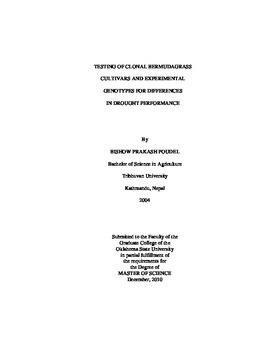| dc.contributor.advisor | Moss, Justin Quetone | |
| dc.contributor.author | Poudel, Bishow Prakash | |
| dc.date.accessioned | 2014-04-15T22:32:27Z | |
| dc.date.available | 2014-04-15T22:32:27Z | |
| dc.date.issued | 2010-12-01 | |
| dc.identifier.uri | https://hdl.handle.net/11244/9592 | |
| dc.description.abstract | Bermudagrass is used in many parts of the world as a forage crop and as turfgrass in sports fields, golf courses and lawns. Selection and identification of drought resistant bermudagrass cultivars under acute or chronic drought stress is important for sustainable turfgrass management and water conservation. The objective of this research were to: 1) identify differences in overall field drought performance of selected industry standard and OSU experimental bermudagrass entries; and 2) evaluate and explain differences in root growth characteristics of selected clonal industry standard and OSU experimental bermudagrass entries. This research was conducted at the Oklahoma State University Turfgrass Research Center in Stillwater, OK. Twenty-three clonal bermudagrasses were used in the field study for objective 1 while eight clonal bermudagrasses were used in the greenhouse study for objective 2. Based on the overall results from the field study, the hypothesis that were differences in bermudagrass entries for their field drought performance was accepted. At the 0% ET irrigation level, the OSU experimental bermudagrasses that performed lower than Celebration but better than all other entries were #2, #12, #16, #24, and #27. At the 33% ET irrigation level, Celebration, #2, #12, and #27 performed better than all other bermudagrass entries. Based on the overall results from the greenhouse study, the hypothesis that there were differences in bermudagrass entries for their root growth characteristics was accepted. Celebration, OKC 1119, and #2 have great genetic potential for improved drought performance if proper root growth occurs during the year before a drought event. Tifsport, Patriot, and #12 did not perform as well as Celebration, OKC 1119, and #2 in this study and thus may not have great genetic potential for improved drought performance due to rooting characteristics. | |
| dc.format | application/pdf | |
| dc.language | en_US | |
| dc.publisher | Oklahoma State University | |
| dc.rights | Copyright is held by the author who has granted the Oklahoma State University Library the non-exclusive right to share this material in its institutional repository. Contact Digital Library Services at lib-dls@okstate.edu or 405-744-9161 for the permission policy on the use, reproduction or distribution of this material. | |
| dc.title | Testing of Clonal Bermudagrass Cultivars and Experimental Genotypes for Differences in Drought Performance | |
| dc.type | text | |
| dc.contributor.committeeMember | Bell, Gregory E. | |
| dc.contributor.committeeMember | Martin, Dennis L. | |
| dc.contributor.committeeMember | Wu, Yanqi | |
| osu.filename | Poudel_okstate_0664M_11215.pdf | |
| osu.college | Agricultural Sciences and Natural Resources | |
| osu.accesstype | Open Access | |
| dc.description.department | Horticulture and Landscape Architecture Department | |
| dc.type.genre | Thesis | |
| dc.subject.keywords | bermudagrass | |
| dc.subject.keywords | drought | |
| dc.subject.keywords | leaf firing | |
| dc.subject.keywords | root character | |
| dc.subject.keywords | root shoot ratio | |
| dc.subject.keywords | turf quality | |
